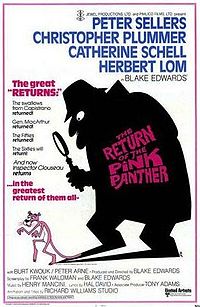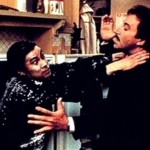 I was ten years old when my parents took me to see The Return of the Pink Panther in 1975. At the time, the only Pink Panther I was acquainted with was of the Saturday-morning cartoon variety, so I figured I was going to see an animated film. But aside from the main titles, that wasn’t the case at all.
I was ten years old when my parents took me to see The Return of the Pink Panther in 1975. At the time, the only Pink Panther I was acquainted with was of the Saturday-morning cartoon variety, so I figured I was going to see an animated film. But aside from the main titles, that wasn’t the case at all.
What I ended up seeing that evening was much funnier than any cartoon I’d ever watched. The antics contained therein consisted of — but were not limited to — a guy getting himself stuck in a desk, glued to a chair, and sucked into a vacuum cleaner. What was not to love? My idea of a great movie at that point in my life was The Strongest Man in the World, The Love Bug, or pretty much anything starring Dean Jones. No disrespect to Herbie or Mr. Jones, but I’d never laughed that hard in a movie theater before.
I eventually discovered that The Pink Panther was a movie before it was a cartoon: in 1963 director Blake Edwards unleashed upon an unsuspecting public what turned out to be the first film in a long-running series. Our animated friend was first seen during the title sequence, animated by David H. DePatie and Friz Freleng.
The Pink Panther was a caper picture about legendary jewel thief Sir Charles Lytton, a.k.a. the Phantom (David Niven). Though he eventually became the focal point of the series, Peter Sellers’s bumbling police inspector, Jacques Clouseau, was more of a supporting character on the trail of the Phantom in the first film. The plot centered on Lytton’s plans to steal the most famous diamond in the world, which is known as the Pink Panther due to a flaw in its center that some claim is panther shaped.
Clouseau proved so popular that a sequel, A Shot in the Dark, was rushed into production and released a year after The Pink Panther. While the pink diamond played no part in the film, many Panther movie aficionados consider Shot to be the funniest entry in the series. Ignoring 1968’s Inspector Clouseau, which was made without the involvement of Edwards, Sellers, or even composer Henry Mancini, it wasn’t until ’75 that the next sequel, The Return of the Pink Panther, was released.
Christopher Plummer took over from Niven in the role of the Phantom, now a retired jewel thief out to prove his innocence after the famous diamond is stolen from a high-security museum in Lugash, a (fictional) country in the Middle East. At the insistence of the shah, Clouseau is assigned to the case, much to the annoyance of the French SuretÁ©’s chief inspector, Charles Dreyfus, who’s played beautifully, with eye-twitching goodness, by Herbert Lom.
 The slapstick comedy that ensues is comedy gold. My favorite bits in the Pink Panther series were always the elaborate fight sequences involving Clouseau and his manservant, Cato (Burt Kwouk), who’s been instructed by his boss to attack him from time to time in an effort to keep Clouseau’s combat skills sharp. The Return of the Pink Panther contains my favorite of all the Clouseau-Cato fights, which begins with a frosty Cato springing from a refrigerator. What follows is some good pain and destruction as the duo practically annihilate Clouseau’s kitchen, with some of the funniest uses of slow motion I’ve ever seen.
The slapstick comedy that ensues is comedy gold. My favorite bits in the Pink Panther series were always the elaborate fight sequences involving Clouseau and his manservant, Cato (Burt Kwouk), who’s been instructed by his boss to attack him from time to time in an effort to keep Clouseau’s combat skills sharp. The Return of the Pink Panther contains my favorite of all the Clouseau-Cato fights, which begins with a frosty Cato springing from a refrigerator. What follows is some good pain and destruction as the duo practically annihilate Clouseau’s kitchen, with some of the funniest uses of slow motion I’ve ever seen.
In 2004 Blake Edwards received an honorary Academy Award and accepted it by speeding across the stage in an out-of-control wheelchair, crashing offstage. To my mind, this makes him a true genius of slapstick comedy. He was always fond of shooting his scenes in long takes, in the tradition of great silent-film comedians like Buster Keaton.
The revolving-door gag in The Return of the Pink Panther is a good example, a bit that involves Clouseau, a suitcase, and a hotel bellboy and plays out for two minutes in a single, continuous shot, then concludes with another great bit that’s completely unrelated to the revolving door (someone who appears to work for the hotel approaches Clouseau and asks “Can I take your coat and your gloves and your hat?” before walking through the door, into the parking lot, and driving away). Peter Sellers is undoubtedly one of the greatest comic actors of his or any other time, but the way Edwards sets up the gags in the Pink Panther films is equally important. (Robert Zemeckis is another director who likes to shoot his scenes in long takes, as discussed in my write-up of Back to the Future.)
The Return of the Pink Panther was followed in 1976 by another hilarious entry in the series, The Pink Panther Strikes Again, which contains another amazing Clouseau-Cato fight, and 1978’s Revenge of the Pink Panther, which turned out to be the last sequel Sellers shot — he died in 1980.
In 1982 Edwards directed Trail of the Pink Panther, with Sellers “returning” as Clouseau by way of outtakes from previous films. Edwards then attempted something of a series “reboot” with 1983’s Curse of the Pink Panther, starring Ted Wass (Blossom) as a bumbling New York cop, and 1993’s Son of the Pink Panther, with Roberto Benigni playing the bumbling offspring of Clouseau. Son was the last film scored by Henry Mancini and, to date, the last film directed by Edwards.
I’ll conclude with a little bit of Clouseau-v.-Cato fun, as seen in the brief clip below.
[kml_flashembed movie="http://www.youtube.com/v/cpv6QUpzwh8" width="600" height="344" allowfullscreen="true" fvars="fs=1" /]

![Reblog this post [with Zemanta]](http://img.zemanta.com/reblog_e.png?x-id=d8f4edb4-47fe-4bb7-b21d-a2171834e75f)



Comments